What is Chain Surveying? Its Type, Uses, Advantages and Disadvantages.
What is Chain Surveying?
Chain Surveying is a method of surveying that involves taking measurements linear only and used where accuracy is not required, In this Method the measuring land is measured and distanced by a chain to create a series of point or connected points/ lines, this method of surveying is commonly used in small-scale survey, such as residential or small plot, in flat terrain. this technique of surveying is most basic and common and only measure linear measurement we cannot measure angular measurement / horizontal measurement. Chain Surveying is a valuable skill due to its simplicity (easy to use), Affordability ( Easy to get, buy), Effectiveness ( Measure land in easy and accurately)
Application of Chain Surveying
- Boundary surveys
- Construction projects
- Topographical surveys
- Agricultural applications
Chain Surveying Instruments / Accessories
The instruments that are used in chain surveying is
- Chain
- Tape
- Pegs
- Arrow
- Ranging Rods
- Offset Rods
Chain
Chain : Chain is the most important part in chain surveying, there are mainly 4 types of surveying chain that are commonly used in any survey, made with galvanizes iron/ Mild steel of 4mm diameter and handle made with brass, in every 1 Meter distanced a circular ring in attached.

The types of chain in Surveying are as follows :
| S.No. | Type of chain | Length of chain | Number of links |
| 1. | Revenue chain | 33 ft | 16 links |
| 2. | Gunter’s chain | 66 ft | 100 links |
| 3. | Engineer’s chain | 100 ft | 100 links |
| 4. | Metric chain | 20 m | 100 links |
| 30 m | 150 links |
NOTE: 1 Mile = 80 Gunter Chain : 1 Acre = 10 X (Guntur Chain)2 = 10 x 66 x 66 = 43560 Ft2
TAPE
Tape: The measuring instrument is called tape, it comes in various type and measurement and easily available in any hardware store, Based on the materials, weights and lengths.
Types of tape used in surveying are as follows:
- Cloth or Linen Tape : Made from cloth and Linen (synthetic material) and varnished to resist moisture, Available in 10 M, 20M, 30M Length, Width of the tape is 12 -15 mm, Due to Stretching its length get affected and can give error, it may twist in affect of wind.
- Metallic Tape : This is the same tape as linin tape but in this tape Brass or copper wire is woven into the tape longitudinally which reduces the stretching in tape, the wires are not visible because of varnished, it is accurate than linen tape, These are available in 20M, 30M Length.
- Steel Tape : It is more accurate than Metallic tape, they are made up of steel strips or stainless steel strips. These are available in 6M – 50 M Length, Width of this tape is about 6 mm to 10 mm, a Brass ring is attached at the starting end of the tape which is zero point of the tape.
- Invar Tape : It is Modified Steel tape that is made from alloy like nickel (36%) and steel (64%). it is used in precise work, They are available in lengths of 30M, 50M and 100M and a width of 6 mm. They are soft so deform easily as such they require much attention in handling. These tapes have a very low multiple of thermal expansion (0.122×10-6°C)
PEGS
Pegs are used as marking definite point in the ground from which measurement is to be taken or if any instrument is to be set. Size of the Pegs is 2.5 – 7.5 CM2 . Length of the Pegs are : 15 – 90 CM.
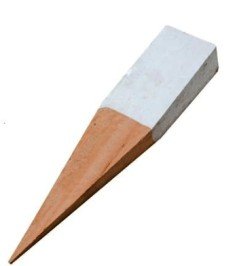
ARROW
They are placed in ground after every chain length/ tape length while surveying, the number of arrow is inserted by the follower indicates the number of chain that have been measured
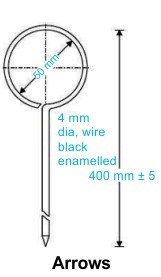
RANGING RODS
The process of locating a number of intermediate points on long survey line, these rods are used to locate intermediate point such that these point on straight line joining and station, Ranging rods are 30 mm in Dia and 2-3 M long painted with alternate band of either red and white or Black and white of 200 mm Length each colour.
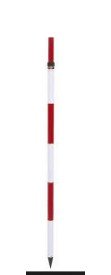
OFFSET RODS
These rods are similar to ranging rods with only difference is that they are provided with hook and opening at top and two narrow vertical slot at right angle to each other at eye level.
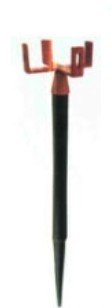
Basic Terms Used in Chain Surveying
Some of the basic term which is used in chain surveying which is mentioned in given picture, if the surveying land is big or large it is recommended to divide the area in smaller fragment area.
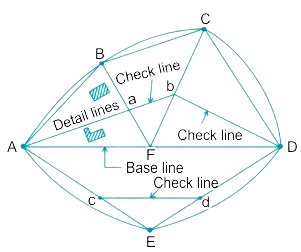
- MAIN Station : It is a point where the chain triangular line meet it is basically the survey boundaries. (A,B,C,D,E) these are main station in a survey.
- TIE Station: Tie station is also known as subsidiary station and the station which is on main survey line joining two main survey line, they are helpful in inner detailing of survey area, in figure A,B,C and D.
- MAIN Survey Line: The chain line joining two tie station T1,T2 in figure.
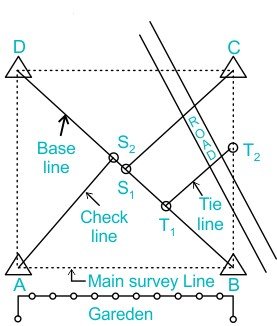
- BASE Line: It is the longest main survey line on level ground, it passes through the Centre of the area, it is very important line in survey area, here line DB is a Base line.
- CHECK Line: Check line is also called as proof line, it is drawn to check the accuracy of the survey, AS2 and CS1.
- OFFSET : The perpendicular line or oblique line drawn in the lateral distance of a point in Survey.
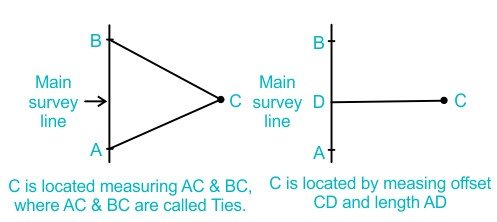
Advantages of Chain Surveying
- Simple and accessible
- Cost-effective
- Durable and reliable
- Good for small areas
Disadvantages of Chain Surveying
- Time-consuming
- Limited accuracy
- Labor-intensive
Procedure in Chain Survey
- Reconnaissance
- Marking Station
- Fixing ranging poles
- Driving pegs
- Marking across if the ground is hard
- Digging and fixing a stone.
- Then selects the way for passing the mainline, which should be horizontal and clean as possible and should pass approximately through the center of work.
- Then the ranging roads are fixed on the stations, after fixing the stations, chaining survey could be started.
- Make ranging wherever necessary.
- Measure the change and offset.
- Enter in the field the book.